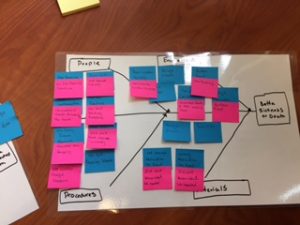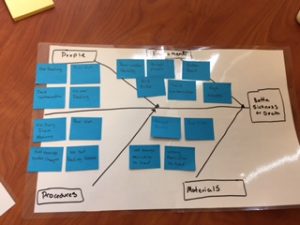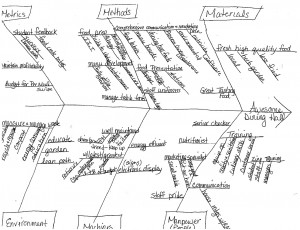A few weeks ago, I learned the importance of Root Cause Analysis and the difference a few LEAN tools can make. Unfortunately I had to learn this lesson the hard way.
My room is filled with fish. Between my roommates and I, we take care of four Betta fish, two feeder fish, and a goldfish. I can admit that it is a lot of work. One night I noticed a problem with one of our Bettas, Haru. Haru had gone from his usual energetic self, to sitting on the bottom of the tank and I hadn’t a clue as to why. Immediately I jumped into action, trying everything I could to make the little guy feel better. I tried everything, heating his tank, cleaning his water, even an extra snack for the night. The next morning, Haru seemed worse. Within two days, we had lost Haru to whatever had made him sick. I tried everything to save the little guy, except applying my LEAN thinking.
After loosing Haru, I decided to learn from my mistakes. My biggest mistake of treating Haru was that I hadn’t preformed any form of Root Cause Analysis. The problem with ignoring Root Cause Analysis is that I only treated the symptoms, and I never treated the source of the symptoms. The trick to lean is that you have to find the problem in order to fix the problem.
I decided to use a Fishbone Diagram to try and determine the cause of Haru’s Sickness. To start the Fishbone Diagram, my roommate and I brainstormed everything we could think of that might have caused Haru’s sickness. Modifying the Diagram slightly for our fish tanks, we separated these problems into categories. We decided to group them by, problems with materials, problems in his environment, problems with the way people interact with the fish, and procedures in place for the fish routine and maintenance. Once we had our diagram set out, we started asking why. For each problem we listed, we first determined if the problem existed in our tank systems. Then We used the 5 whys to find the cause of each problem. After all of our analysis, we determined that Haru’s sickness was caused by poor water quality. The water quality was a result of over feeding, or contamination of the tanks. The overfeeding was a result of a lack of feeding schedule. The fish were being double fed because we didn’t know that the other room mate had already fed them. The contamination was caused by miscommunication to guests. we never made it quite clear who, or what could touch each fish’s tank. Once we knew the root cause, we were able to fix the problem. By posting a feeding schedule and rules for the tanks we have been able keep all of our other fish happy and healthy.
In the world of problem solving, root cause analysis is easy to forget. It can become a habit to treat the symptoms without ever discovering the real problem. As with our Haru, treating the symptoms can have disastrous consequences. As I continue learning and using LEAN, I will have to remember, You have to find the problem to fix the problem.


